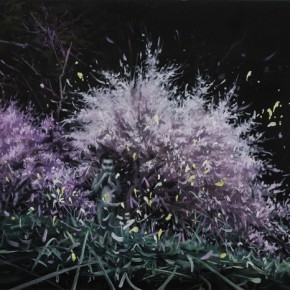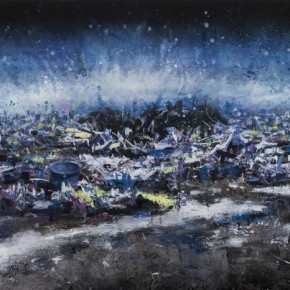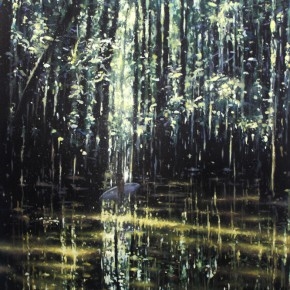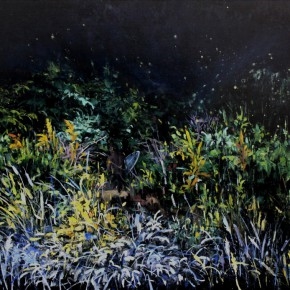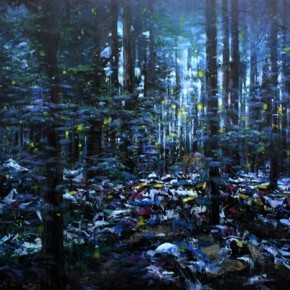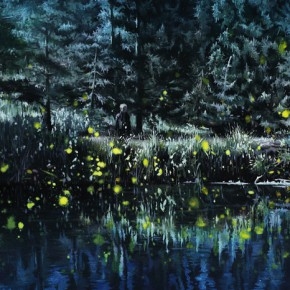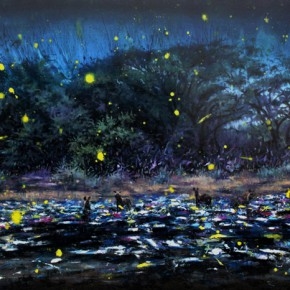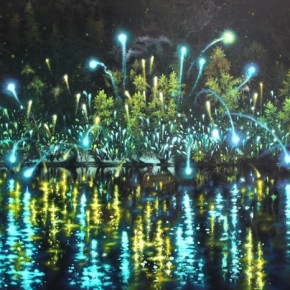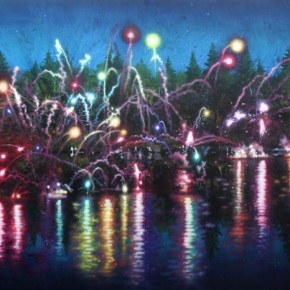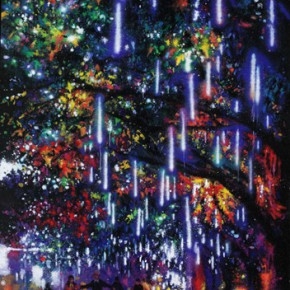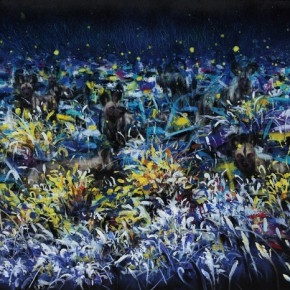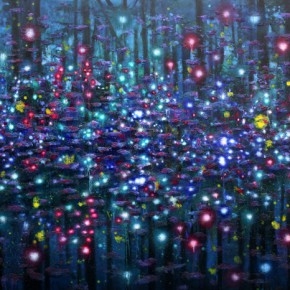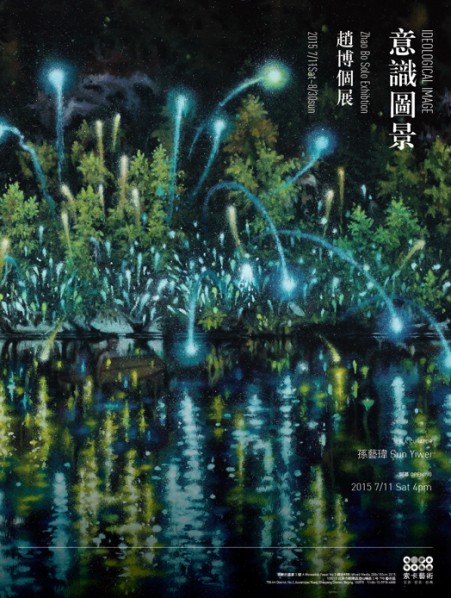
Viewable “Ideology”–An Analysis of Zhao Bo’s Works
By Sun Yiwei
"When drawing, there is always something you can do. Drawing will not cease to exist. We can always find the life force that exists in its tradition. It will carry on."–David Hockney
Since the 1970s, there has been talk that oil painting is becoming a lost art. A few decades later, this rumor has proven untrue. Not only have oil paintings not faded away, they have been continually propagated by artists from different eras and different regions, over and over again. Of those who have ventured out into new representations of visual image, Zhao Bo, is one of them. Born in 1984, Zhao Bo was calmer and more rational than others at his age. In his art works, Zhao doesn’t merely follow those who went before him, nor is he overly sensitive toward politics, and nor does he base his works on grand stories. He chose not to base his studio in Beijing, the capital of Chinese contemporary arts. Zhao was born and raised in Northeast, and he continues to work there to this day. As an educated painter with a solid academic background, he uses his own methods of observation to display internal survival and growth. In his works, he expresses his perceptions and thoughts on society. At the same time, Zhao reflects an “ideology” that has appeared or formed, yet the majority of society still cannot see. Through the visual images in his works, a viewable “ideology” is produced, originating simultaneously from both society and Zhao Bo himself. He aims to bring the truest ideological image to the audience, inspiring viewers to examine the ideology of their own existence. Zhao wants to remind those of us who live in this society of overwhelming internet information, that if computers and cell phones were to one day disappear, a sense of nothingness will engulf our consciousness.
Before 2014, Zhao Bo’s works recorded his constant growth in awareness and psychological development. These works included “The Lost World” series and “One Man’s Sceneries” series of 2008, “The Fallen Angel” series of 2009, “The Language of Socrates” series of 2010, “The White Planet” series of 2011, “Revelation” series of 2012, “Wilderness” series, “Hope is in the Distance” series and “Forest of Desires” series of 2013. The images are often spacious, oblique and barren, with a sense of uncertainty, lack of sense of belonging and anxiousness hidden in them. Pyramids are placed on top on of a frozen river that is endless in sight. Meanwhile remains of a plane are abandoned in a sea of flowers. There are abandoned places, forests that are full of life and leafless branches. Behind these dreamy, beautiful scapes, shapes that take on the forms of endangered animals or heroic space pilots are placed right in the middle. Zhao Bo takes his chosen objects and puts them in places that don’t belong to Zhao Bo’s creations. The characteristic about Zhao Bo’s works is the sense of surrealism and the use of ridiculous, dreamlike colors. Behind the illogical placement is the momentary state of human Ideology that Zhao Bo discovers. He hopes the audience gets lost in the images he creates and leaves the fictitious sensual world of reality. This way, we can reflect on the authenticity of our awareness of survival. On the one side of the image is reality, the other is fantasy. Zhao Bo’s solid academic skill for realism allows him to place reality and fiction side by side freely. He takes the audience in with sketches of shapes, then derives from them a lot of unreal hidden contradictions and conflicts. All these are seemingly harmonious, but are actually discordant, fantasy visual images.
In Zhao’s new creations, 2014-2015’s “A Beautiful New World” series, where there were once space pilots, now there are real people. These people appear to be faintly discernible. If the audience doesn’t look closely, it would be very easy to overlook these tiny images of people. In addition, looking at the visual appearance of these pieces, the new elements are all in the depiction of light (sunlight, moonlight or lights and smoke of the city). The scenes found in the images are no longer wide angles or empty expanses of barren wilderness with the forms of people hinted at and hidden within. From 2014 and onward, Zhao Bo was realized that “the most important thing about art is being honest. See your life honestly. Whether it’s Fan Kuan, Ma Yuan, Andy Warhol, Milan Kundera, Marx or Tolstoy, they all face their lives with honesty. That’s why their works are wholesome and touching. When you view their works, you can feel and understand the era they lived in.” Currently Zhao Bo can face his life and his works with more honesty. He believes that we live in an era in which virtual internet information space is intertwined with real society. Our lives seem so spectacular and colorful, but what have we lost underneath the beautiful neon lights? Therefore, Zhao Bo’s images bring the audience into a lost world. This lost world is just the lost state of being overlooked by modern society. Zhao Bo’s works record his perceptions of life and society. He used to create perfectly beautiful surreal dream worlds, but now he’s deconstructing this dream-world style he created. In its place, he creates fantasy patterns of ideology in a state of truth, asking his audience to enter a deeper state of thought. He is still expressing a kind of ideology that people cannot see through visual representation alone. This kind of ideology changes with the artist’s perception of society, life and his own personal growth. However, every moment of every stage is also a true reflection of the ideology. He records everything for his audience, hoping that they will be able to examine their own state of ideology anew. As societies develop at high speed in the globalised world, we are in a world engulfed by overwhelming amounts of information. People are paying less and less attention to their own state of ideology. Mental and material wastelands are everywhere. People are lost in them, completely unaware. What seemed to be extreme happiness is, in reality, civilization in a never-ending state of loss. What seemed to be a prosperous, dazzling, beautiful new world is, in fact, full of different senses of loss and humanity itself also in state of loss. Rationalized self-reflection on humanity is a different way in which these visual images want to get their message across to the audience. The large amounts of forestry in the background of Zhao's works are a kind of landscape unique to northeastern China. Zhao Bo extracted these images of forests from his own memory, turning them into one of the elements of his visual expression. Zhao Bo believes that the forest is always connected to life. He abandons mankind in a relatively primitive, natural environment, so these de-socialized men can face themselves with honesty. What comes after is an enormous sense of loneliness and weakness.
Zhao Bo expresses a real state of living with his detailed observations. Humanity’s existence is individualistic so they are bound to be lonely. To escape from loneliness, people are willing to move toward lively and bustling places. After flourishing, people die and all that there was disappears. In the end, people are bound to just be drops in the ocean, full of tragedy. Zhao Bo paints a visual image of "One Hundred Years of Solitude" and in it, the rhythms and melodies of the picture come together to form an overriding harmony. Every point, every line, every side or different block of color ultimately forms a complete image representing the artist’s ideas towards the implications that our ideology imbues upon our state of living. Zhao Bo visualizes his ideology, producing a growing ideological image in the context of Zhao Bo’s interpretation. He does not have the sense of restlessness that pervades the modern art world. Rather, he keeps a rare sense of serenity. He truthfully records his perception of the world in his own way. He is constantly contemplating whilst remaining true to life. Not only did he not fall into the system of conceptualization, he found "A Beautiful New World" through his works.
27 May, 2015
About the exhibition
Curator: Sun Yiwei
Duration: July 11- August 30, 2015
Venue: Soka Art Beijing
Courtesy of the artist and Soka Art Beijing.


